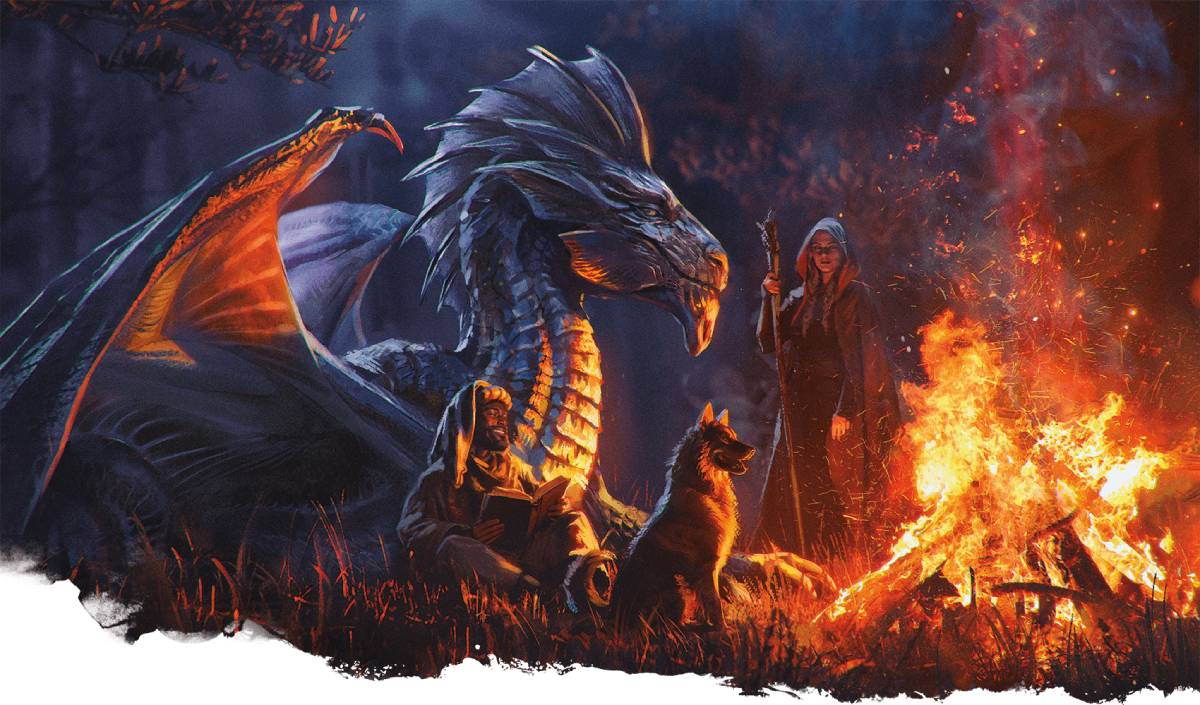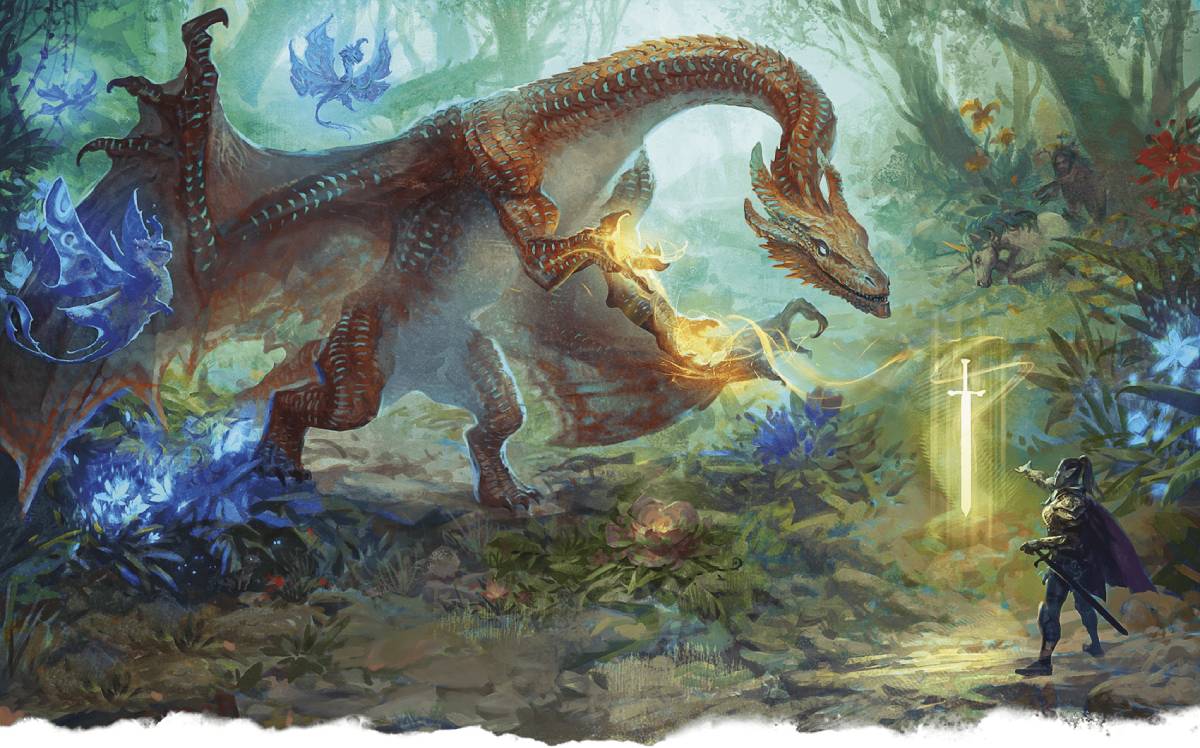We've all heard the tales. A knight in shining armor, a dragon curled atop a mountain of gold, and the eventual battle to the death between the two. But in Dragon Delves, releasing July 8, you'll find a collection of ten draconic adventures where the dragons you encounter are more than just a foe to conquer.
Read on to learn how you can use the advice in the Core Rulebooks to run social encounters between your players' characters and the dragon sitting across from them at the bargaining table.
- Forging a Dragon's Personality
- Let the Characters Discover Information About the Dragon
- How to Run a Social Encounter with a Dragon
Forging a Dragon's Personality

The first step in creating meaningful social encounters is creating a memorable NPC for the adventurers to interact with. Dragons are excellent monsters to use for detailed, fully-realized NPCs who can serve as antagonists, allies, mentors, or patrons.
To craft a dragon your players will never forget, you can get a head start by grounding their personality and motivations in a few essential traits from their Monster Manual entries.
Keep Track of Your NPCs
The NPC Tracker is a free resource in the D&D Beyond Basic Rules that provides a template to help you flesh out your NPCs. Download it and give it a try today!
Monster Tendencies
Each dragon entry in the Monster Manual offers a broad sketch of that dragon's worldview, habits, or social inclinations. Brass dragons are gregarious lore-seekers, gold dragons are noble and wise, silver dragons are empathetic peacekeepers, and so on. These tendencies can serve as your first layer of personality—an archetype you can then customize into a unique character.
Using Alignment and Ability Scores to Shape Personality
These aspects provide useful indicators for creating personalities that reflect a dragon's temperament and presence.
Alignment. A dragon's alignment is a compass for its behavior. Is it a creature of law and tradition, or one of impulse and freedom? Is it moved by compassion, curiosity, or conquest? The Dungeon Master's Guide encourages using alignment as a foundation for defining NPC behavior. To give your dragon more dimension, you can also choose a personality trait tied to its alignment from the Personality Traits by Alignment table in the D&D Beyond Basic Rules.
Ability Scores. With the baseline traits established, you can layer in descriptors inspired by the dragon's highest and lowest ability scores. A Lawful Good Adult Silver Dragon with high Wisdom but low Intelligence might be deliberate and reserved, but stuck in their ideology. A Chaotic Good Young Brass Dragon with high Charisma and low Wisdom might be eccentric and friendly, but easily tricked.
Add in Memorable Details
As with any other NPC, don't feel bound by a dragon's stat block. You can add in bonds, flaws, and ideals that are tailored to your particular dragon and their past experiences. What have they lost? What do they protect? What do they regret?
If you're looking for deeper inspiration, Fizban's Treasury of Dragons offers a wealth of rollable tables designed specifically for fleshing out dragons. Its Draconomicon chapter also includes unique personality traits and ideals for each dragon type—from story-hungry brass dragons to solitary white dragons.
Find Detailed Dragon NPCs in Dragon Delves
Dragon Delves features ten adventures, each centered around a unique dragon with a fleshed-out backstory and distinct personality. If you’re looking to add more dragons your players can parley with—or clash against—this collection of adventures is a perfect place to start.
Let the Characters Discover Information About the Dragon

Encounters with a dragon don't typically happen by accident. Simply crossing paths with one of these incredibly powerful beings is often the culmination of an entire adventure.
As that adventure progresses, your characters should learn more about the terrifying creature they are about to confront. Did it destroy an entire civilization to claim their stronghold and has since slept upon a pile of its gold? Has it been a guardian of an ancient library for a millennium?
This information will enable the characters to understand the dragon's personality and ideals, allowing them to formulate a strategy when it comes time to negotiate.
Tell a Story Through the Dragon's Lair
They say that home is where the heart is, and that's true for dragons as well. If the dragon's lair is full of scorched piles of bones or frozen statues of intruders, your party will know they have to approach the situation delicately.
But not every dragon is viciously territorial. Some value what they protect, but they want those who seek it to be worthy of the cause. For example, a gold dragon could place a number of trials throughout their lair that test the mettle of those that seek a powerful magical item contained within their hoard.
How to Run a Social Encounter with a Dragon

Dragons have the power to tyrannize regions, reshape landscapes, and hoard unimaginable wealth and knowledge. There should be a reason your players are meeting this dragon, and the way they approach the interaction sets the scene for any alliance or battle that might follow.
Establish a Goal
The Dungeon Master's Guide suggests that social interaction should usually have a goal. Perhaps if you succeed on an Influence check in a tavern, the innkeeper might knock a few Silver Pieces off your tab.
But when your conversation partner is a two-ton, fire-breathing dragon, the consequences scale up fast. Fail that check, and your party might be on the receiving end of a fiery rebuttal.
What do the party members want? To bargain for forbidden lore? Or to talk their way out of becoming tonight's dinner?
Keep in mind that a dragon will likely have its own goals, and they should be just as clear. What does it want from the adventurers? What values does it hold dear, and how can the players affirm or challenge them?
Use Attitude and Shift It
The Dungeon Master's Guide suggests that each NPC start with an initial attitude toward the characters:
- Friendly. If the party is being introduced by one of the dragon's trusted acquaintances, it might start off with a Friendly attitude.
- Indifferent. A stoic gold dragon might begin as Indifferent, waiting to judge the characters' intentions.
- Hostile. If the dragon encounters the adventurers skulking around its lair or stealing from its hoard, it might have a Hostile attitude.
It's then important to note how characters approach the situation. Are their requests aligning with the dragon's goals or nature? Or is what they're asking risky?
Once that's established, some tables prefer to roleplay the scenario to completion, whereas others resolve the outcome using ability checks, typically by way of the Influence action.
If the mood of the encounter shifts, show it. If the characters' plea resonates with the dragon, let the dragon's interest deepen and its wings relax. Conversely, if they fail to sway the dragon, its temper (and perhaps other things) may flare.
Players should feel like the characters' words are carving a path forward, or cracking the thin ice beneath their feet.
How to Win Friends and Influence Dragons
Treating dragons as more than just monsters to conquer helps open the door to deeper, more complex stories. Your party could forge an alliance with a benevolent gold dragon or an unsteady ceasefire with a ferocious red dragon.
In Dragon Delves, you'll discover ten adventures featuring dragons where parley can be just as powerful as combat. If you're ready to embark on your own draconic journey, you'll receive a digital and physical copy of the book, the exclusive Ancient Gold Dragon Digital Dice Set, and the Dragon Lairs Digital Maps Pack with the Dragon Delves Ultimate Bundle.
Pre-order today to unlock early digital access starting June 24 for Master Tier subscribers and July 1 for Hero Tier subscribers!

Mike Bernier is the founder of Arcane Eye, a site focused on providing useful tips and tricks to all those involved in the world of D&D. Outside of writing for Arcane Eye, Mike spends most of his time playing games, hiking with his partner, and tending the veritable jungle of houseplants that have invaded his house.








-
View User Profile
-
Send Message
Posted Jun 7, 2025This is great. Would love to share it somehow.
-
View User Profile
-
Send Message
Posted Jun 8, 2025I pre-ordered this at my local gane shop. When I didn't get the chance to have the cool art when I ordered the bundle digitally for the players, dmg and monsters manual. So now have the good art but I don't get a digital copy because I ordered off line. Why do you folks just give me bad choices , either I loose my miniature budget and buy a second copy of a book I don't need or I have a worse experience running your product for a table of players because I can't reference the book easily. Your a big company figure out how to make it fun giving my money to you and I'll do it more.
-
View User Profile
-
Send Message
Posted Jun 9, 2025I agree. I truly don't understand why they don't include a DnDBeyond code in the physical books sold since they now OWN 100% OF ALL OF THEM. All it would do is increase the use of DnDBeyond and generate more sale of physical books.